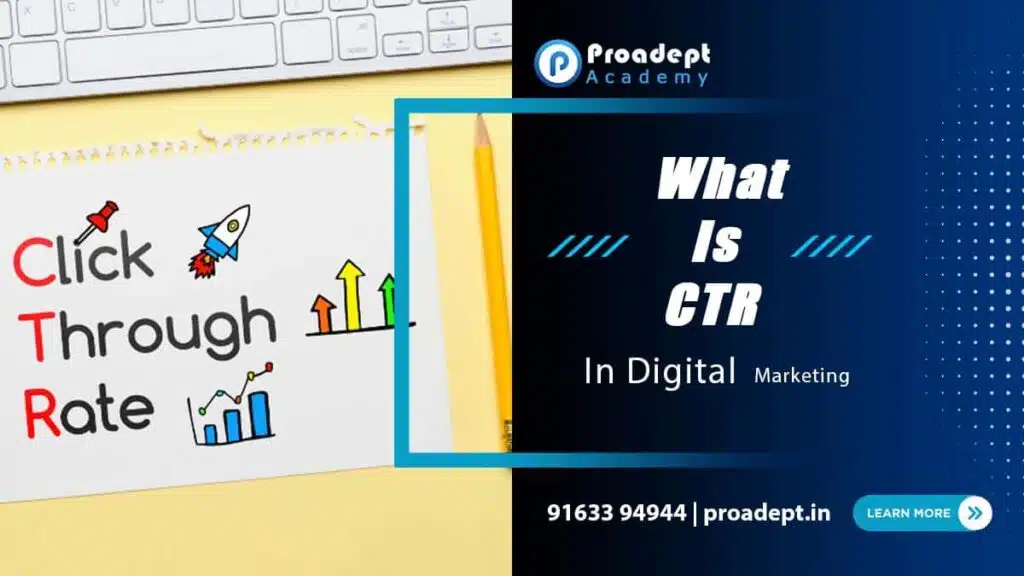Understanding What is CTR in Digital Marketing: A Key Metric for Success
Discover the fact what is CTR in digital marketing and the way it impacts campaign success. Learn what impacts CTR, why it matters, and techniques to optimize it effectively.
Proadept Academy, the best digital marketing institute in Kolkata, wrote this guide to help you understand what is CTR in digital marketing and the keys to higher engagement and conversion rates. It will also help you understand how to improve CTR. Here you go:

Nowadays businesses must comprehend many phrases and metrics to navigate effectively in the measurable digital marketing landscape. One crucial metric is CTR or Click Through Rate. Understanding CTR in digital marketing is critical for marketers aiming to optimize their campaigns and power significant consequences. Therefore, what is CTR, and why does it count?
Introduction to What is CTR in Digital Marketing?
Click Through Rate, abbreviated as CTR, is a fundamental metric in digital marketing that measures the ratio of clicks to impressions for a particular commercial, email, or webpage. In simpler terms, it indicates the share of people who clicked on a hyperlink or advert after being exposed to it.
The formula for calculating CTR in digital marketing is straightforward:
[ CTR = Numbers of clicks / Numbers of Impressions X 100]
For example, if a campaign, whether organic or paid, receives one hundred clicks and 10,000 impressions, the CTR would be 1%.
Learn Online Marketing at Your Own Pace. Learn Advanced Techniques.
Why is CTR Important in Digital Marketing Campaigns Performance?
1. Performance Evaluation:
CTR in digital marketing presents precious insights into the effectiveness of advertising campaigns. A good CTR or Click-Through-Rate represents that the ad or content is resonating correctly with the target audience, while a low CTR means that changes can be made to improve engagement.
2. Relevance:
A good CTR in digital marketing campaigns means the content material or advert applies to the target audience’s interests and needs. It demonstrates that the message aligns with what the target audience seeks, leading to a higher likelihood of conversion.
3. Cost-Effectiveness:
If you want to know “what CTR in digital marketing”, you must understand the cost-effectiveness affecting the advertising cost in paid campaigns, including Google Ads or Facebook Ads. A better CTR typically decreases cost-per-click (CPC), as structures reward ads that generate extra engagement with reduced prices.
4. Quality Score:
Many advertising platforms use CTR in digital marketing as part of their high-quality score algorithms. A better CTR regularly leads to better campaign engagement, which could result in better ad placements and lower costs.
Factors Influencing CTR in Digital Marketing
Several elements can impact the CTR of digital marketing campaigns:
- Ad Copy: Compelling ad copy that grabs interest and communicates cost concisely tends to have higher CTRs.
- Relevance: Ads or content relevant to the audience’s interest and demographics and seeking rationale are more likely to garner clicks.
- Visuals: The use of appealing visuals, such as images or videos, can considerably affect CTR by attracting attention and conveying messages efficaciously.
- Ad Placement: The placement of commercials on a webpage or inside an email can influence the overall CTR in digital marketing campaigns. Ads placed prominently and seamlessly included in the content material tend to carry out higher.
- Targeting: This is focused on ensuring that advertisements are shown to the most relevant target audience, increasing the probability of clicks.
How to Improve CTR in Digital Marketing
Here are some helpful factors to help you understand “what CTR is in digital marketing” and how to improve CTR for better campaign performance.
1. Optimize Ad Copy:
Experiment with unique headlines, descriptions, and CTA or call-to-action to discover the most exciting combination.
2. Use Relevant Keywords:
Incorporate applicable keywords into ad copy to improve relevance and visibility.
3. Test Different Ad Formats:
Test exceptional ad formats, such as search, display, or video ads, to see which resonates nicely with your target market.
4. Refine Targeting:
Continuously refine audience targeting based on demographics, pastimes, and behaviours to reach the maximum engaged users.
5. Monitor Performance:
Monitor CTR in digital marketing ad campaigns and relevant metrics regularly to stay informed of developments and make records-driven optimizations.
One can look after these factors to improve CTR in the overall campaign.
Conclusion
Click-through-rate or CTR in digital marketing is a critical metric that measures the effectiveness of campaigns by indicating the ratio of users who click on an ad or link. Understanding What is CTR and its influencing factors is crucial for optimizing advertising efforts, enhancing relevance, and achieving higher outcomes.
The best institute for digital marketing in Kolkata like Proadept Academy will always advise you to improve CTR through compelling content, unique targeting, and continuous optimization can help marketers improve campaign performance and attain their goals more effectively.
FAQs
CTR or click through rate in digital marketing to measure the ratio of clicks to impressions for a specified campaign, e-mail, or website. It shows the share of customers who clicked on a campaign link.
CTR can be calculated by dividing a campaigns overall clicks by impressions and multiplying by 100 to get a percentage. The calculation process is CTR=(Number of Clicks / Number of Impressions) x 100.
CTR is crucial as it provides insights into the effectiveness of advertising and marketing efforts. A high CTR suggests that the ad or content material reflects well with the target audience; at the same time, a low CTR shows the craving for adjustments to improve engagement and output.
CTR directly affects marketing costs in paid ads like PPC or Facebook ads. A higher CTR results in a lower CPC, making campaigns more cost-effective.
Join the Best Digital Marketing Training in India. Accelerate your career path.
Unlock More Opportunities

Inquiry Here

- Top 10 Low-Budget PPC Strategies for Small Businesses
- A Quick Guide to Understanding the Relationship Between SEO and Content Marketing
- A Quick Guide to the Difference Between SMO and SMM
- A Quick Guide to the Importance of Digital Branding for Small Business
- What are the Upcoming Digital Marketing Trends to Follow?
Table of Contents
- 1 Understanding What is CTR in Digital Marketing: A Key Metric for Success






